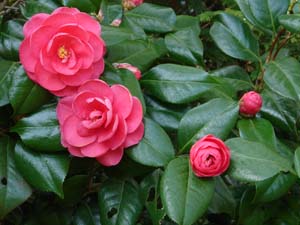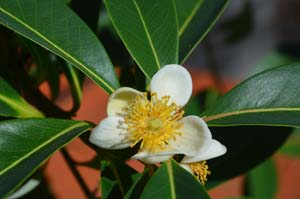Related Genera of the Theaceae
The Theaceae (tea family) is a relatively small family comprised of genera that thrive around the world. Most famous for Camellia sinensis, from which most tea is derived, the family contains many horticulturally and ethnobotanically significant plants. Besides stewartia, Polly Hill Arboretum is home to four other genera and one intergeneric hybrid, × Gordlinia.
Camellia
Camellia is likely the most well-known member of the Theaceae family. It is prized both for the beauty of its flowers, which can bloom from December to April, as well as the source of tea leaves.
Native to eastern and southern Asia, it is a relatively large genus with over 100 species, which has grown even larger with the introduction of many different cultivars. You can enjoy camellias at Polly Hill along the Camellia Border as well as in Polly’s Play Pen.

Camellia japonica
Franklinia
Franklinia alatamaha is a monotypic genus native to North America. It was first discovered in the 1700s in the swamps of Georgia, but has since been declared extinct in the wild. Due to extensive cultivation at its discovery, the Franklin tree (named for Benjamin Franklin) can still be seen in gardens worldwide. At Polly Hill, you can see examples of the franklinia in the West
Field and Polly’s Play Pen. For additional photos and a technical description of the species, click here.
Gordonia
Gordonia, much like its Theaceae relatives, is a prized ornamental tree. Primarily native to southern Asia, one species, Gordonia lasianthus, is native to the southeastern United States. Currently, all gordonias at Polly Hill were collected in the wild in Georgia by curator Tom Clark. Following in Polly’s footsteps, these plants were grown from seed, and while still being evaluated for adaptability to our climate and soil, if worthy they will be a delightful addition to the grounds in the coming seasons. × Gordlinia is an intergeneric hybrid between Gordonia lasianthus and Franklinia alatamaha. A single, young specimen of this unique plant can be found in the Nursery Field close to the Julian Hill magnolia.
Schima
Schima is an evergreen tree native to Southeast Asia, ranging from Nepal to Taiwan. In its native region it is valued for its ethnobotanical qualities as an important tree for construction as well as for the medicinal properties of its bark. Here at PHA you can a specimen of Schima argentea in Polly’s Play Pen. For additional photos and a technical description, click here.

Schima argentea
